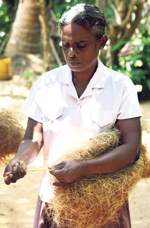
Fishing in troubled waters |
|
Hambantota – A coir worker wades into a murky, green-coloured pond in a southern Sri Lanka village and keeps fishing out soaked coconut husks that are then dried and the coir spun into rope, matting and brooms.
“This is how we do it,” the woman says, smiling, as she grabs a husk and flings it onto the ground. After the husks are fished out of the water manually by mostly women, dozens of coconut husks are then beaten to further soften the fibre and then dried at a large garden beside a stream fed by a nearby lagoon. The process can take three to four months at a time.
The coir (coconut fibre) business, essentially a cottage industry and composed mostly of women, is slowly recovering from the December 2004 tsunami which destroyed coir producing units (beach coir pits, lagoon coir pits and coir mills) and equipment (mainly manual coir yarn spinning machines) on the coast. But there are also dozens of Sri Lankan companies who export high, quality coir products.

Making of brooms. |
|
Many non-governmental organizations like Oxfam UK stepped in to revive these business and help the women on their feet. In July in this southern town, 49 Community Based Organizations (CBO) –made out of 205 Self Help Groups (SHG) - came together to form a CBO Federation to actively promote and support female coir workers as the owners and managers of the assets, resources and processes of this industry.
With financial and technical expertise from Oxfam, the Federation wants to increase access to improved production techniques, high quality raw materials and more lucrative markets for coir workers. Coir industry workers like G.C. Kusumawathie say the support from the CBO Federation and Oxfam has helped her return to a normal routine workday.
Kusumawathie, whose beach coir pits were destroyed by the tsunami, now buys machine-made coir and weaves them into rope. Working with three others as a unit, they are able to produce 50-60 units of rope working from around 8 to 12 noon and again from 2 pm to 6 pm. “We make an average Rs 4,000 a month per person,” she says, adding that their fishermen-husbands help out mostly during the monsoon when the seas are too rough for fishing. During these non-fishing days, earnings from coir is the only income for the family.

Beating the husk |
|
K.D. Daya Padmini, a community facilitator hired by Oxfam to work on the project, says the CBOs – each of which may have 60 to 100 members -- run their own banking units aimed at helping the women. Each member donates Rs 40 per month and from these collections, members are entitled to a loan at 5 % interest. Loans upto Rs 3,000 are given for business purposes like buying the coir, etc
However Himali Hemakeerthi, Programme Assistant, at Oxfam’s Matara office says Oxfam has provided a cash grant to the women and while this is used to improve the industry, the CBO loans are now used for other family needs. “Our project started after the tsunami as the coir industry was in a deep crisis and many women had lost their livelihood,” she added. The CBO Federation represents more than 200,000 coir-weavers and their families.
The machine-made coir is not as good as the beach-pit coir where the waves repeatedly wash away the brownish colour from the husks and turn these into clean, white coir.
An Indian-made rope making machine – similar to a handloom weaving machine -- is installed at an old building and operated by women like D.B Nandasiri who has been trained to work the machine.
While these women in cottage industries struggle away to produce mostly rope, mats and brooms for local consumption, there are dozens of Sri Lankan companies who export high, quality coir products. These fibres are either sold as raw material in the international market or processed into products such as brooms, brushes, twine, matting, woven and stitched geotextiles, rubberized coir mattresses, and upholstery.

Rope making |
|
According to official statistics, Sri Lanka is the single largest supplier of brown coir fibre to the world market, and together with India accounts for almost 90% of global coir exports.
Coir-related exports accounted for 6 % of agricultural exports, over 1 % of all exports, and 0.35 % of GDP in Sri Lanka in 2005.
The soaking-wet coir worker clambers out of the murky, coloured pond and says – in response to a question - that the ponds are no health hazards. “There are no mosquitoes,” she says. In a gesture of goodwill to a team of visiting reporters, another woman from the village sits on the ground and deftly ties two or three coconut husks together, stringing them with coloured rope onto stick to make a traditional broomstick. “This is for you,” she says after a quick 5-minute job.
Marketing of their products is a common product and often the broom which is sold to the middleman for 40 rupees per broom fetches 70 or 80 rupees in the market. “They don’t have any marketing skills, so they get a poor price. The next level of development is to teach them to sell their products themselves instead of relying on the middle-man,” said Thushara Dharmasiri, another Oxfam official.
(Feizal) (Pix by J. Weerasekera) |




